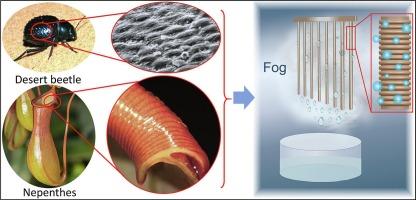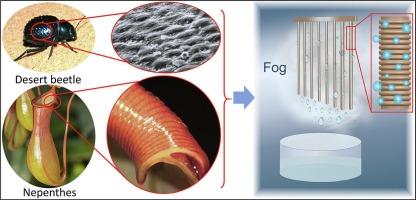Bioinspired slippery harp structures optimized by simulation for efficient fog harvesting
IF 13.2
1区 工程技术
Q1 ENGINEERING, CHEMICAL
引用次数: 0
Abstract
Atmospheric water harvesting represents a crucial method for mitigating the crisis of water resources and has garnered significant attention from researchers, and the harp structured fog collector (HSFC) stands as a straightforward apparatus for this endeavor. To refine the design of fog collectors for enhanced efficiency, this work has delved into the impact of wire pitch and diameter on water collection capacity, employing aerodynamic analysis and empirical studies. Furthermore, drawing inspiration from the distinctive surface properties of Nepenthes and the Desert beetles, this paper has engineered a bioinspired slippery HSFC with stable and cost-effective silica gel-infused groove surface, which can effectively promote the rapid removal of droplets and improve the efficiency of water collection. This advancement has yielded about 60 % increase in water collection efficiency relative to the hydrophilic HSFC. These findings offer a valuable trajectory for the enhancement of water collection surfaces and the evolution of fog collection technology.


仿生滑溜竖琴结构通过模拟优化,有效的雾收集
大气水收集是缓解水资源危机的一种重要方法,已经引起了研究人员的极大关注,而竖琴结构雾收集器(HSFC)是一种简单的设备。为了改进雾收集器的设计以提高效率,本工作深入研究了钢丝间距和直径对集水能力的影响,采用空气动力学分析和实证研究。此外,本文还从Nepenthes和Desert beetles的独特表面特性中获得灵感,设计了一种具有稳定且具有成本效益的注入硅胶凹槽表面的仿生光滑HSFC,该材料可以有效地促进液滴的快速去除,提高集水效率。与亲水性HSFC相比,这一进步使集水效率提高了约60% %。这些发现为水收集表面的增强和雾收集技术的发展提供了有价值的轨迹。
本文章由计算机程序翻译,如有差异,请以英文原文为准。
求助全文
约1分钟内获得全文
求助全文
来源期刊

Chemical Engineering Journal
工程技术-工程:化工
CiteScore
21.70
自引率
9.30%
发文量
6781
审稿时长
2.4 months
期刊介绍:
The Chemical Engineering Journal is an international research journal that invites contributions of original and novel fundamental research. It aims to provide an international platform for presenting original fundamental research, interpretative reviews, and discussions on new developments in chemical engineering. The journal welcomes papers that describe novel theory and its practical application, as well as those that demonstrate the transfer of techniques from other disciplines. It also welcomes reports on carefully conducted experimental work that is soundly interpreted. The main focus of the journal is on original and rigorous research results that have broad significance. The Catalysis section within the Chemical Engineering Journal focuses specifically on Experimental and Theoretical studies in the fields of heterogeneous catalysis, molecular catalysis, and biocatalysis. These studies have industrial impact on various sectors such as chemicals, energy, materials, foods, healthcare, and environmental protection.
 求助内容:
求助内容: 应助结果提醒方式:
应助结果提醒方式:


